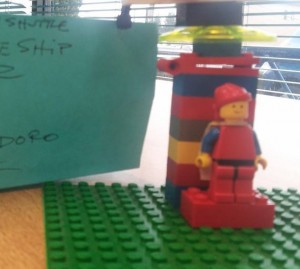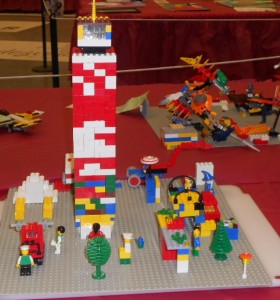This month, Lego celebrated the anniversary of its patent, granted in 1958. The name Lego comes from the Danish ‘leg godt’ which means ‘play well’. That’s certainly what kids do, and not just kids. Kids and adults all over the world play and learn with Lego.

Tremendous fun, Lego can help kids develop critical thinking and kindergarten readiness skills. For instance:
- manipulating, connecting, stacking, balancing, etc. This strengthens the small muscles in hands and fingers and gives children the opportunity to develop eye-hand coordination.
- visualizing, that is making pictures in the mind. As an adult, have you ever had to look at an object and then had to choose from 3 or 4 pictures what it would look like from the other side? This is quite a challenge and this skill develops from lots of experiences and play.
-

Lego at the Fair exploring space and measuring. Blocks of some sizes might fit in a space but some will be too big or too small. That’s also spatial manipulation.
- counting and making groups, matching sizes and shapes. These are early math skills.
- creating and imagining. These are powerful skills, at the very heart of innovation, that begin when kids play.
- solving-problems, organizing and planning. We often consider these as “work” skills but, to kids, they are fun and part of play.
When children play with these Legos or Duplos, they practice negotiating, cooperating and other social skills. Kids are using language to express themselves, explain, and ask questions. Both boys AND girls enjoy playing with these toys!! For a play-of-the-day fun activity can your child make some learning and kindergarten readiness connections with Lego?

Great write-up! My son and I play lego constantly. I hadn’t considered using it to teach counting and adding though. Good call!